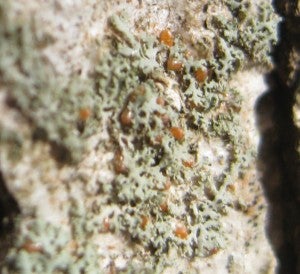March 4, 2016 winter moth information and update
Winter moth in Southern New England 2016
I’m afraid winter moth eggs will be hatching in March as they did in 2010 & 2012. The earliest hatch date recorded was March 21, 2012. I’m worried this year egg hatch could be even earlier. I set up tree wraps in 4 locations in RI, one in CT and several Massachusetts blueberry growers also set up tree wraps. The tree wraps encouraged female winter moths to lay eggs just below the tree wraps. I’ve removed the tree wraps at four locations and found hundreds of eggs to monitor. Winter moth eggs start out orange, but then turn blue a few days before hatching. Very handy for monitoring egg hatch! All eggs I’ve checked this week are still orange, but that may change next week with predicted warm weather.
For landscape trees it’s not important to control winter moth just when hatching, but for apple, pear, and blueberry growers it’s very important. Once eggs hatch, winter moth caterpillars wriggle into swollen buds and begin feeding. For apple & pear trees and blueberry bushes, swollen buds are primarily flower buds. Caterpillars crawl inside the flower buds and begin feeding. Once caterpillars are inside buds they are protected from insecticide sprays until just before bloom and by this time many flowers may have been damaged or destroyed, destroying the crop. Landscape trees, on the other hand, can withstand early winter moth feeding damage. To save landscape trees from being defoliated, insecticides can be applied after trees leaf-out, but while caterpillars are still small and before excessive feeding damage has occurred.
Dormant oil can be applied before eggs hatch, but this may not be very effective if there are unsprayed trees near where you are applying dormant oil or if you cannot get complete coverage with an oil spray. Winter moth eggs are often located in bark nooks and crannies, so complete oil coverage is very difficult. If you do intend to apply dormant oil, next week (March 7-13) could be a good time, though you want to make the application when temperatures are above freezing and will remain above freezing for 24 hours after application.
Winter moth caterpillars are pretty easy to kill, provided they are not inside closed buds. Insecticide choices for when caterpillars start to hatch for fruit growers include, but are not limited to, spinosad, Imidan, Sevin, Malathion and synthetic pyrethroids such as Asana. Spinosad products are Delegate, mostly for commercial growers, Entrust for organic growers, and Captain Jack’s Deadbug Brew is formulated for small-scale growing. Adding a dormant oil may be useful for the first spray of any of the listed insecticides.
Once buds are open, B.t. kurstaki products (Bacillus thuringiensis kurstaki) such as DiPel and Biobit work well. For landscape trees, winter moth caterpillars can be controlled once trees leaf out with spinosad (Conserve), B.t. kurstaki (Dipel Pro, Javelin, and others), as well as synthetic pyrethroids such as bifenthrin. B.t. products are a good choice because they kill only caterpillars, but B.t. products break down in sunlight after 3-5 days so may need to be reapplied more frequently.
Winter moth caterpillars continue to feed and grow until around the end of May. Once mature they drop to the ground, dig down a few inches, and pupate. Pupae will remain in the soil until November or December when winter moths emerge as adults. It’s male moths that we see at porch lights and headlights, especially on warm evenings just after dusk between Thanksgiving and Christmas. Females are rarely seen because they don’t fly.
Dr. Joe Elkinton from University of Massachusetts, has released a parasitic fly that attacks only winter moth caterpillars. The fly, Cyzenis albicans, has successfully controlled winter moth outbreaks in Nova Scotia in the 1950’s and the Pacific Northwest in the 1970’s. Cyzenis albicans lay eggs on leaves of winter moth host plants. When eating leaves, winter moth caterpillars accidentally eat fly eggs too. A fly egg hatches and the larva develops inside a caterpillar body. When a parasitized caterpillar drops to the ground to pupate, it digs into the soil but instead of a winter moth caterpillar pupating, the fly pupates instead. The fly pupa remains in the soil until the following spring when it emerges as an adult fly at the same time winter moth eggs hatch.
Parasitic flies have been released in 49 locations in New England since 2006. In Wellesley, Massachusetts, Dr. Elkinton has found winter moth population declining due to high rates of parasitism. In Rhode Island we’ve released flies in 7 locations and recovered flies for the first time in 2014 in Goddard Park. In a few years we hope to start seeing many more populations of winter moth controlled by Cyzenis albicans.
Winter moth eggs are much smaller than this picture shows. I need to use a 10x handlens to see them.
 Home
Home Browse
Browse Close
Close Events
Events Maps
Maps Email
Email Brightspace
Brightspace eCampus
eCampus



